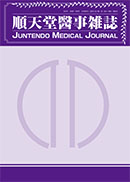Volume 60, Issue 1
Displaying 1-20 of 20 articles from this issue
- |<
- <
- 1
- >
- >|
Contents
-
2014Volume 60Issue 1 Pages 1
Published: 2014
Released on J-STAGE: July 31, 2014
Download PDF (469K)
Health Topics for Tokyoites: The Bowels and Health
-
2014Volume 60Issue 1 Pages 2-7
Published: 2014
Released on J-STAGE: July 31, 2014
Download PDF (1037K) -
2014Volume 60Issue 1 Pages 8-15
Published: 2014
Released on J-STAGE: July 31, 2014
Download PDF (11852K) -
2014Volume 60Issue 1 Pages 16-24
Published: 2014
Released on J-STAGE: July 31, 2014
Download PDF (2900K) -
2014Volume 60Issue 1 Pages 25-34
Published: 2014
Released on J-STAGE: July 31, 2014
Download PDF (13691K)
Original Articles
-
2014Volume 60Issue 1 Pages 35-42
Published: 2014
Released on J-STAGE: July 31, 2014
Download PDF (525K) -
2014Volume 60Issue 1 Pages 43-48
Published: 2014
Released on J-STAGE: July 31, 2014
Download PDF (854K) -
2014Volume 60Issue 1 Pages 49-55
Published: 2014
Released on J-STAGE: July 31, 2014
Download PDF (12982K)
Lecture Note
-
2014Volume 60Issue 1 Pages 56-62
Published: 2014
Released on J-STAGE: July 31, 2014
Download PDF (6008K) -
2014Volume 60Issue 1 Pages 63-65
Published: 2014
Released on J-STAGE: July 31, 2014
Download PDF (438K)
Case Studies
-
2014Volume 60Issue 1 Pages 66-68
Published: 2014
Released on J-STAGE: July 31, 2014
Download PDF (2103K) -
2014Volume 60Issue 1 Pages 69-71
Published: 2014
Released on J-STAGE: September 17, 2014
Download PDF (3207K) -
2014Volume 60Issue 1 Pages 72-73
Published: 2014
Released on J-STAGE: July 31, 2014
Download PDF (1047K) -
2014Volume 60Issue 1 Pages 74-78
Published: 2014
Released on J-STAGE: July 31, 2014
Download PDF (3139K) -
2014Volume 60Issue 1 Pages 79-81
Published: 2014
Released on J-STAGE: July 31, 2014
Download PDF (2603K)
Other articles
-
2014Volume 60Issue 1 Pages 82
Published: 2014
Released on J-STAGE: July 31, 2014
Download PDF (508K) -
2014Volume 60Issue 1 Pages 83
Published: 2014
Released on J-STAGE: July 31, 2014
Download PDF (515K) -
2014Volume 60Issue 1 Pages 84
Published: 2014
Released on J-STAGE: July 31, 2014
Download PDF (399K) -
2014Volume 60Issue 1 Pages 85
Published: 2014
Released on J-STAGE: July 31, 2014
Download PDF (402K) -
2014Volume 60Issue 1 Pages 86
Published: 2014
Released on J-STAGE: July 31, 2014
Download PDF (581K)
- |<
- <
- 1
- >
- >|
